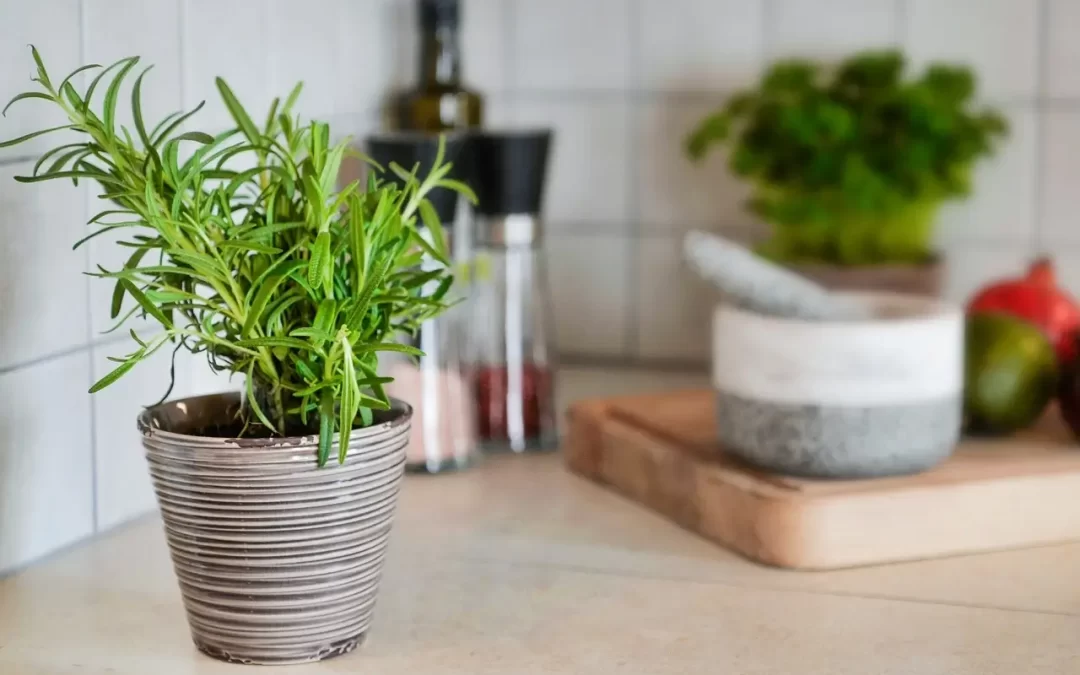Whether you’re a seasoned home cook, a plant enthusiast, or want to spruce up your home with greenery, plants in the kitchen will boost your living space. Transform your kitchen from functional to vibrant with the addition of edible plants.
Plants enhance the aesthetic appeal, and edible options offer fresh herbs and veggies for your family to enjoy. Here are helpful tips for caring for plants in your kitchen.
Cultivating Edible Plants in the Kitchen
There’s something satisfying about plucking a fresh basil leaf or snipping off cilantro right where you prepare your food. The convenience of having these living ingredients at arm’s reach means you can elevate the flavor and nutrition of your dishes at a moment’s notice.
Start Small
If you’re new to houseplants or have limited space, start with herbs. Compact and easy to maintain, herbs like basil, parsley, mint, and chives are excellent plants for beginners. Many herbs thrive on windowsills, basking in the sunlight and proximity to your cooking space.
How to Display Plants in the Kitchen
- Vertical Gardens: Maximize your kitchen’s vertical space using hanging pots or wall-mounted planters. Grow strawberries and nasturtiums vertically and save countertop space.
- Window Solutions: Install a sturdy shelf across a sunny window and line it with your favorite herbs and small vegetables. Choose compact varietals like cherry tomatoes and strawberries.
- Tiered Plant Stands: Add a plant stand in a sunny corner for variations in height and visual interest. Group plants with similar water and light needs together.
- Create a Centerpiece: Choose a bold plant, like pineapple, to create a dramatic centerpiece on the dinner table.
The Essentials of Edible Indoor Plant Care
While these plants are in your home and safe from the harsher elements of the outdoors, they still require proper attention to thrive. Keep your kitchen plants healthy.
- Sunlight: Most edible plants need plenty of sunlight. A south-facing window is ideal for maximizing sun exposure.
- Watering: Overwatering can be just as harmful as neglect. Verify your pots have good drainage and soil that retains moisture without becoming waterlogged.
- Pruning: Regularly harvest and prune your plants to encourage new growth. Pruning is especially necessary for herbs like rosemary and sage, which can become leggy and sparse if not trimmed.
Health and Wellbeing from Your Kitchen
It’s not just your cooking that benefits from your in-home herb garden. Plants contribute positively to your well-being by improving mental health, purifying the air, and boosting mood and productivity – making your time in your kitchen all the more enjoyable.
With adequate sunlight and occasional watering, homeowners and home cooks can cultivate a kitchen garden to enhance meals. Edible plants add color, texture, and nutrition to your kitchen space.
FAQs
Can I tell if an edible plant is getting too much water?
Yes, there are signs that a plant is receiving too much water, including yellowing or wilting leaves, mushy or discolored stems, and waterlogged soil. Additionally, if the plant’s pot feels heavy and the soil is consistently wet, it may be a sign of overwatering. Monitor the plant’s water needs and adjust watering frequency accordingly to prevent root rot, mold growth, and other issues.
What herbs are easiest to grow indoors?
Many herbs thrive in indoor environments and are easy to grow. These herbs add flavor to your culinary creations and provide beauty and freshness to your kitchen space.
- Known for its aromatic leaves and versatility, basil grows well indoors with ample sunlight and well-draining soil.
- Mint is a hardy herb that thrives in indoor containers, preferring moist soil and partial sunlight.
- Parsley is a versatile herb that grows well indoors with moderate sunlight and regular watering.
- Chives are resilient herbs that tolerate indoor conditions well, requiring moderate sunlight and regular watering.
Are there vegetable plants that grow well indoors?
Yes, some vegetable plants can thrive indoors with proper care and conditions. Popular options include cherry tomatoes, dwarf pepper varieties, and leafy greens (including lettuce and spinach).
What types of containers are best for growing herbs?
When growing herbs indoors, choose containers that provide good drainage to prevent waterlogged soil. Opt for containers made of porous materials like terracotta or ceramic, as they allow excess moisture to evaporate efficiently. Verify the containers have drainage holes at the bottom to allow water to escape. Choose planters with sufficient depth to accommodate the herb’s root system and provide stability.
Can I grow edible flowers in my kitchen?
Yes, many edible flowers can be grown indoors in containers or pots with proper care. Some edible flowers suitable for indoor cultivation include nasturtiums, violas, calendula, and lavender.
Lakeland Home Inspection Service provides professional inspection services to customers in Lakeland, FL, and the surrounding area. Contact us to request an appointment.

